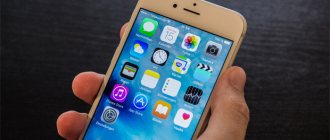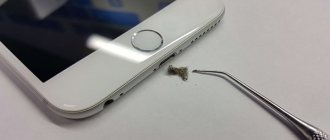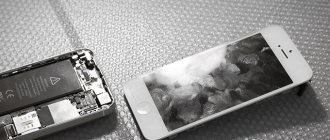Domestic users of Apple devices believe that their mobile phones come from the USA, Japan, Taiwan - anywhere, but not from China. Russians have long had an extremely negative image of Chinese production - as if they do everything “on the knees”, in conditions of terrible unsanitary conditions and prefer quantity to quality.
This is actually a misconception. In China, the situation is the same as in other countries (for example, in Russia): there are underground production facilities that assemble penny devices from low-grade components, and there are also official factories whose assembly lines produce first-class products.
Apple produces the iPhone and iPad in cooperation with China, but this is by no means a reason to hang offensive labels on Apple devices.
Where are the original iPhones designed?
iPhones and iPads are developed at Apple's head office, which is located in the American state of California, in the city of Cupertino. This is confirmed by the inscription that is present on the back edges of all Apple devices: “Designed by Apple in California.”
The following activities are performed at Apple headquarters:
- Software creation (iCloud, iTunes, iOS).
- Design development for Apple gadgets.
- Planning of marketing and advertising events.
- Logistics planning.
- Pricing.
- Quality control of finished products. Apple takes final quality control very seriously - this is why the percentage of defects among products is minimal.
Mobile market experts claim that 99% of the total contribution to the creation of Apple gadgets is made by the employees of the Cupertino office - despite the fact that many of these employees have never seen how the devices are assembled.
Is the long-term partnership over?
Apple may fall out with its main partner in the production of its technology, Foxconn. The culprit, as reported by The Information, is Foxconn’s repeated attempts to deceive its client, some of which were actually successful.
Foxconn seeks to deceive Apple, being dissatisfied with its financial performance. While Apple boasts 40 percent gross margins, Foxconn's gross margins are in single-digit percentage points, prompting it to resort to questionable methods to boost its profits.
One recent example of such methods concerns the iPad Pro 2018 tablets, which, as reported by CNews, took place at the end of October 2022. A few months before the premiere, when Foxconn began production tests of the updated tablets, it informed Apple that in order to complete all work on testing and production of these devices requires more workers.
In the relationship between Apple and Foxconn, the latter's regular requests for staff expansion have long been the norm, but in the case of the iPad Pro 2018, Foxconn clearly overestimated the staff shortage figures. But it ended up hiring fewer people than Apple said it would. Thus, she received more money from her to cover expenses than she needed.
The future of the Apple-Foxconn partnership is in grave danger
The Information, citing numerous employees of the Chinese company, writes that this case was not a precedent. Foxconn has pulled similar scams before in an attempt to gain more profits or attract new business from Apple to boost its razor-thin margins.
Where are iPhones assembled?
The plant of the Taiwanese company Foxconn is where iPhones are made for Russia and other countries. The Foxconn plant is located in the Chinese city of Shenzhen, near Hong Kong. He has been collaborating with Apple since 2007. Apple is not the only Foxconn partner; a giant Chinese factory produces almost 40% (!) of the world's electronics.
The Foxconn factory area is 5.6 million square meters. km, number of employees – 1 million 250 thousand people. Every day, 400 thousand new iPhones roll off the Foxconn assembly line, each of which fully meets the high standards set by Apple.
Foxconn has been repeatedly accused of forcing its employees to work in truly slave-like conditions. Chinese workers allegedly spend 12-14 hours at work, 6 days a week, eat rations of food sold on the streets, and are also discriminated against by their Taiwanese colleagues. Apple conducted many audits, which resulted in the discovery that most of the accusations of violation of labor laws are unfounded.
Buyers often wonder: why doesn’t the Apple company produce gadgets in its own country? There are many reasons for this:
- Americans are too highly educated. In the United States, there is a shortage of citizens with secondary technical education who are able and willing to perform routine, monotonous operations every day.
- Chinese labor is quite cheap. The salary of a Foxconn employee is 300 – 400 dollars per month. An American would have to pay four or five times more.
- The USA has high taxes. If iPhones were assembled in America, then due to additional insurance and taxes, the final cost of the Apple product would be doubled.
- China produces the lion's share of rare earth metals, which are necessary when creating mobile gadgets. If Apple were to move its smartphone production to another country, it would have to negotiate exports with China—not an easy task.
Foxconn has factories not only in China, but also in other countries - in the Czech Republic, Hungary, and India. In 2010, the factory was opened in Russia - in the village of Shushary, Leningrad Region. Now there is information that Foxconn is going to build a plant in the USA. Who knows - perhaps this is the first step towards starting the production of native American iPhones?
Factories are stopped
The Chinese government has ordered the temporary closure of a number of factories located in relative proximity to the city of Wuhan. The list includes factories of Samsung and Chinese Foxconn, which is directly related to Apple. The order, according to the ZeroHedge resource, implies a complete shutdown of factories in the country for one to two weeks, but in the future these periods may be adjusted upward.
Factory closures are directly related to the coronavirus epidemic called 2019-nCoV in China. The factories, which are now forced to idle, are located near Suzhou, considered one of the largest manufacturing centers in China. The distance between it and the city of Wuhan, where the spread of the virus began, by road is about 560 km.
Foxconn is Apple's main partner in assembling its devices, in particular iPhone smartphones. The decision of the Chinese authorities primarily affected factories producing products in the FMCG (Fast Moving Consumer Goods) category - consumer goods.
Who supplies components for iPhones?
Workers at the Foxconn plant assemble iPhones from components that are sourced from many countries. There are no Chinese components in Apple devices, but there are American ones. Among them:
- Audio chips are manufactured in the USA by Cirrus Logic.
- Radio modules are produced by the famous company Qualcomm.
- Controller chips are created by American organizations PMC Sierra and Broadcom Corp.
- Touch Screen Controllers – Also manufactured by Broadcom Corp.
Other components are supplied by European and Asian manufacturers - for example:
- Induction coils - Japanese company TDK.
- RAM - Taiwanese organization TSMC.
- Gyroscopes - Italian-French company STMicroelectronics.
The situation with iPhone displays is interesting. Now 3 companies produce this component for the Apple company - Japanese Japan Display and Sharp, as well as Korean Display. However, for the iPhone 8th and 9th modifications, Apple plans to purchase panels only from Samsung - and in huge quantities.
Among the suppliers of components for the iPhone there is a “full” international. Apple prefers to work with trusted and reputable component manufacturers, regardless of the countries in which their factories are located.
Possible consequences
Apple and Foxconn have not yet commented on the publication in The Information. Both companies are quite dependent on each other - according to MacRumors, Foxconn produces 60% to 70% of total iPhone volume annually, while Apple is Foxconn's largest customer.
Denis Ageev, Research Institute “Scale”: The huge potential of virtualization was clear a few years ago
ICT in the public sector
It is not yet known what exactly Foxconn’s repeated attempts to deceive Apple will turn out to be. In recent years, Apple has sought to reduce its dependence on China and even moved part of its iPhone production to India, and iPhones released in that country are now officially sold in European countries. Meanwhile, even in India, Apple cooperates with Foxconn, which has built its own iPhone production plant there.
- The best smartwatches of 2022
Elyas Qasmi
Share Subscribe to news Short link
What is the cost of an iPhone?
Experts from IHS Markit, immediately after the release of the iPhone 7 in 2016, tried to calculate the cost of an Apple device by adding up the costs of all its components, including:
- A10 Fusion processor – $26.9.
- Intel module – $33.9.
- Cameras – $19.9.
- Electromechanical components – $16.7.
According to expert calculations, the cost of the iPhone 7 turned out to be equal to 220 dollars (approximately 13 thousand rubles). The market value of the Apple gadget at the time of inspection was $649 - 37 thousand rubles at the current exchange rate. It is worth saying that this price was relevant for the USA. In Russia, the seventh iPhone even now costs 50 thousand rubles. It’s easy to calculate that in our country, the rate of promotion on Apple devices is almost fourfold.
It is curious that the difference in cost between iPhones of different generations is very small. Let's look at the diagram:
The cost of the iPhone 7 is only $8 higher than that of the iPhone 6S – in fact, 500 rubles. Gadgets of the same generation, but of different modifications (for example, 5 and 5S), as a rule, require equal costs for components. But what was most surprising was that the iPhone SE turned out to be the most economical smartphone in the Apple line (cost price: $160). Even the iPhone 3GS was more expensive to produce.
Huawei's secret help and iPhone deception
In an effort to earn a little more, Foxconn, according to The Information, several times used idle production equipment purchased by Apple to work with other clients. As an example, the situation with Huawei, one of Apple’s main competitors in the smartphone market, was given - based on the results of the second quarter of 2022, Huawei took first place in smartphone shipments in the world, displacing Samsung to second place, and Apple to third.
Timur Zinnyatullin, Angara Security: Development of a commercial SOC is a road without end
Safety
Foxconn used radio frequency equipment purchased by Apple to test Huawei smartphones. How often she did this remains unknown.
Foxconn is even trying to optimize the production process of Apple equipment, reducing costs. An example was given of the iPhone 7 of 2016. During its production, she “creatively” approached the issue of eliminating defects - inside some copies of the smartphone there was a lack of mounting screws, in others there were tiny pieces of metal left over from the production of the frame. According to Apple's rules, such phones are disassembled and recycled, but Foxconn secretly disassembled them, fixed the defects and sent them to Apple under the guise of completely new ones.
To generate more profit, Foxconn tried, with limited success, to sell its own component manufacturing and testing equipment. It even developed its own chemicals to polish the iPhone's screen, rather than relying on chemicals from Japanese suppliers, for example.











